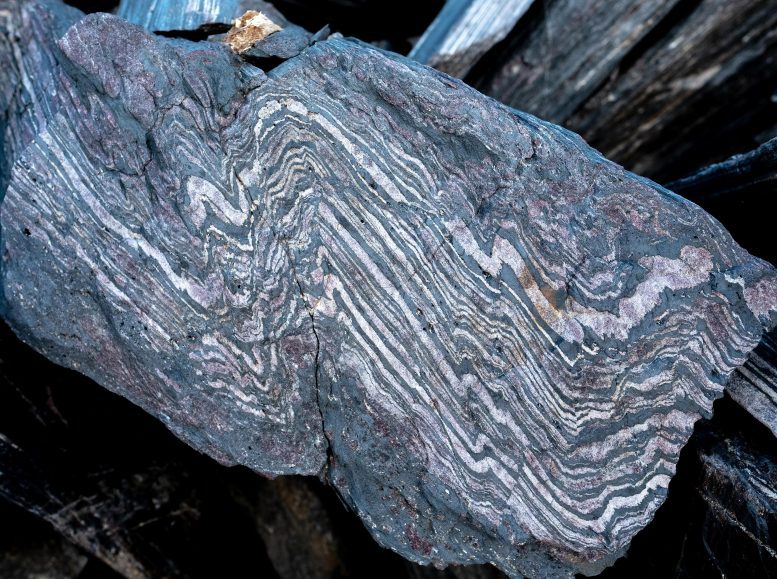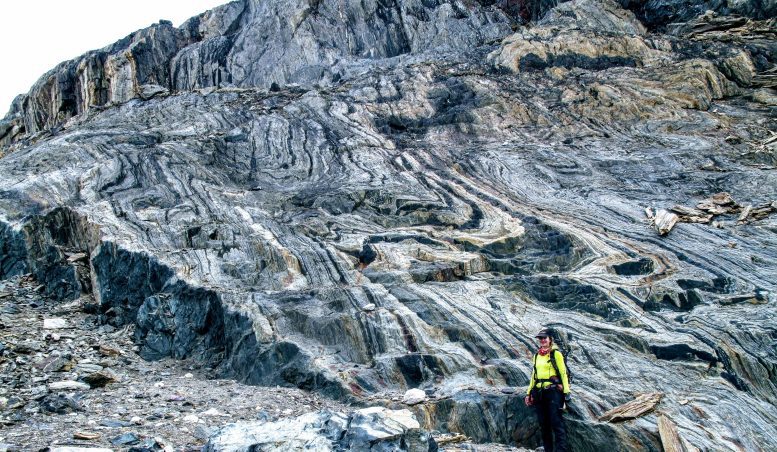
An example of the 3.7 billion-year-old banded iron formation found in the northeastern part of the Isua Supracrustal Belt. Credit: Claire Nichols
Researchers from the University of Oxford and MIT collaborated on a study that revealed a 3.7-billion-year-old record of Earth's magnetic field in Greenland. The findings demonstrate that the ancient magnetic field was as strong as it is today, which is crucial for protecting life from cosmic and solar radiation.
A recent study has uncovered a 3.7-billion-year-old record of Earth's magnetic field and found that it closely resembles the present-day field surrounding Earth. The study has been published on April 24 in the Journal of Geophysical Research. Journal of Geophysical Research.
Life on Earth relies on its magnetic field to shield against harmful cosmic radiation and charged particles emitted by the Sun. However, until now, there has been no reliable date for when the modern magnetic field was originally established.

Samples were taken from different areas to compare the difference between 3.5 billion-year-old igneous intrusions and the surrounding rock, which the researchers have shown contains a record of the 3.7 billion-year-old magnetic field. Credit: Claire Nichols
Examination of Ancient Rocks
In the new study, the researchers examined an ancient sequence of iron-containing rocks from Isua, Greenland. Iron particles can effectively act as small magnets that record both magnetic field strength and direction when they are locked in place during the process of crystallization. The researchers discovered that rocks dating from 3.7 billion years ago captured a magnetic field strength of at least 15 microtesla, similar to the modern magnetic field (30 microtesla).
These findings present the oldest assessment of Earth's magnetic field strength derived from whole rock samples, providing a more precise and reliable evaluation compared to previous studies using individual crystals.

Study co-author Athena Eyster standing in front of a large exposure of banded iron formation, the iron-rich deposit from which ancient magnetic field signals were extracted. Credit: Claire Nichols
Insights From the Study
Lead researcher Professor Claire Nichols (Department of Earth Sciences, University of Oxford) stated: 'Obtaining reliable records from rocks of this age is extremely difficult, and it was truly exciting to see primary magnetic signals begin to emerge when we analyzed these samples in the lab. This is a significant step forward in understanding the role of the ancient magnetic field during the emergence of life on Earth.'
Although the magnetic field strength appears to have remained relatively constant, it is known that the solar wind was much stronger in the past. This suggests that the protection of Earth's surface from the solar wind has increased over time, potentially allowing life to move onto the continents and leave the protection of the oceans.
Earth's magnetic field is generated by the mixing of molten iron in the fluid outer core, driven by buoyancy forces as the inner core solidifies, creating a dynamo. During Earth's early formation, the solid inner core had not formed yet, raising questions about how the early magnetic field was sustained. These new findings suggest that the process driving Earth's early dynamo was similarly efficient to the solidification process that generates Earth's magnetic field today.
Understanding the changes in Earth’s magnetic field strength over time is important for determining when the solid core of Earth began to form. This will help us understand how heat is moving from Earth’s deep interior, which is crucial for processes like plate tectonics.
Geological and Weather Consequences
It’s difficult to reconstruct Earth’s magnetic field from so long ago because heating events can change preserved signals in rocks. Rocks in the Earth’s crust often have long and complex histories that erase previous magnetic field information. But the Isua Supracrustal Belt has a unique geology, sitting on top of thick continental crust which protects it from extensive tectonic activity and deformation. This allowed the researchers to build a clear body of evidence supporting the existence of the magnetic field 3.7 billion years ago.
The results may also give us new insights into how our magnetic field shaped Earth’s atmosphere, especially regarding the escape of gases. An unexplained phenomenon is the loss of the unreactive gas xenon from our atmosphere more than 2.5 billion years ago. Scientists have begun to investigate the possibility that charged xenon particles were removed from the atmosphere by the magnetic field.
In the future, researchers aim to increase our understanding of Earth’s magnetic field before the rise of oxygen in Earth’s atmosphere around 2.5 billion years ago by studying other ancient rock sequences in Canada, Australia, and South Africa. This will help us determine whether planetary magnetic fields are crucial for supporting life on a planetary surface and their role in atmospheric evolution.
Reference: “Possible Eoarchean records of the geomagnetic field preserved in the Isua Supracrustal Belt, southern west Greenland” 24 April 2024, Journal of Geophysical Research Solid Earth.
DOI: 10.1029/2023JB027706



